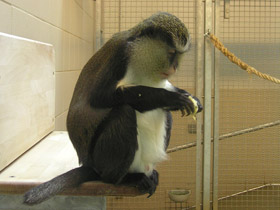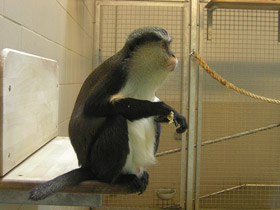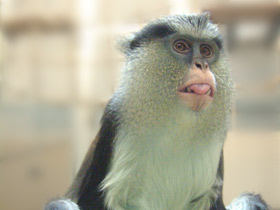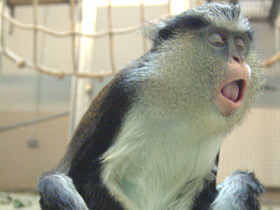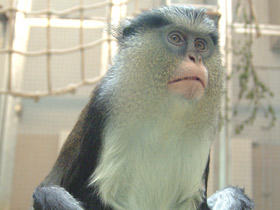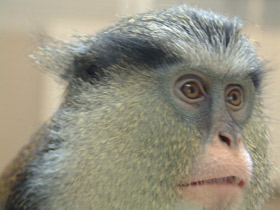The mona monkey (Cercopithecus mona)
The mona monkey (Cercopithecus mona) is an Old World monkey that lives in western Africa between Ghana and Cameroon. The mona monkey can also be found on the island of Grenada as it was transported to the island aboard slave ships headed to the New World during the 18th century. This guenon lives in groups of up to thirty-five in forests. It mainly feeds on fruit, but sometimes eats insects and leaves. The mona monkey has brown agouti fur with a white rump. Its tail and legs are black and the face is blue-grey with a dark stripe across the face. The mona monkey carries food in cheek pouches.
Appearance and habitat
Cercopithecus mona is a species of catarrhine primate of the family Cercopithecidae. Cercopithecus mona is found in western and central Africa and is characterised by its reddish-brown upperparts. These monkeys are slender and graceful, with long arms and legs. Adult males measure 41-63 cm and females 37-45 cm, and weigh between 2.4 and 5.3 kg. Like other monkeys, their tails are long (64-88 cm in males and 53-65 cm in females), straight and inflexible, and serve as balance when jumping in trees.
Nutrition
Cercopithecus mona spends most of its time in the upper canopy levels of tropical forests, but may feed in the middle and lower canopy levels. The basic diet of Cercopithecus monkey consists of various young, juicy fruits and shoots, nuts, seeds; if possible, they eat various insects, wild honey, bird eggs, snails and other bugs (although the proportion of insects in their diet is higher than that of other monkey species).
Lifestyle
Cercopithecus monkeys are diurnal and highly mobile primates. Running along tree branches and reaching the slender end of a branch, they leap to another tree and land safely on all four limbs in an upright posture. Interestingly, these monkeys are good swimmers and use their tails as rudders. In case of danger, these monkeys often freeze and remain motionless among tree branches and foliage until the threat has passed.
Social behaviour
Cercopithecus mona live in groups of 8-35 (sometimes up to 50) individuals (average 12), consisting of mature females, their young and a mature male. The area occupied by such a group is usually about 5-50 acres. But if the group lives in favourable conditions, where food is abundant, several groups may be temporarily combined. Occasionally there are also all-male groups with few individuals (usually 2-4).
Reproduction
Offspring are born after a gestation period of 6 months at any time of the year. The birth of one calf (rarely two) usually occurs at two-year intervals and is observed at night in a tree where the monkeys sleep. The young feed on their mother's milk for about 12 months, after which they switch completely to solid food. Males reach sexual maturity at 4-6 years; females at 3-5 years.
Ecology
The mona monkey is usually found in groups of about twelve individuals, with a single mature male, but larger aggregations also occur. The troop moves through the canopy foraging mainly for fruit, but also eating flowers, seeds and insects and other invertebrates. It is a vocal species with a harsh grating call, and the male issues a "ooer" alarm call. It often associates with other species of monkeys including Lowe's mona monkey (Cercopithecus lowei) and the crested mona monkey (Cercopithecus pogonias).
Status
The mona monkey is a common and adaptable species. Its natural forest habitat has been impacted by much habitat destruction and it suffers from being hunted for food. However the population does not seem to be declining significantly, and the International Union for Conservation of Nature has assessed its conservation status as being near-threatened.

















